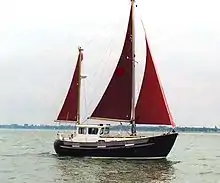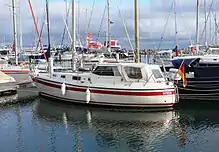Motorsailer
A Motorsailer, aka "motorsailor" (US),[1] is a type of sailing vessel, typically a pleasure yacht, that derives propulsion from its sails and engine(s) in equal measure.[2]



Whereas most sailing yachts above a certain size (say, 7 meters LOA) will usually have an inboard engine, they will not be "motorsailers", as their principal source of power is sail, and the engine is primarily for maneuvering and motoring in light airs. A sailing yacht with an auxiliary engine will typically have a small propeller that automatically feathers when sailing, whereas a motorsailer may have either a large fixed propeller or, ideally, a variable-pitch propeller.[3] Compared to such "pure" sailing yachts, a motorsailer will typically be heavier-built, perhaps with less delicate lines but with more spacious accommodation. A motorsailer will have an enclosed cockpit, or "doghouse", whereas most pure sailing yachts would have an open cockpit. A motorsailer may have a higher freeboard, and, coupled with the doghouse and other superstructure, will have considerable side windage. The motorsailer's sail area will typically be rather smaller than an equivalent yacht's, and any masts may be shorter. Also, while a sailing yacht will often be rigged as a Bermuda rigged-sloop or cutter (both types having a single mast), the motorsailer will more likely have a multi-masted split-rig sail-plan, such as a ketch,[4] yawl or schooner.[5][6]
While the sailing yacht appeals primarily to the purist sailing enthusiast, the motorsailer is more suited for long-distance cruising, or as a home for "live-aboard" yachtsmen.[7] The special features of the motorsailer (large engine, smaller sails, etc.) mean that, while it may not be the fastest boat under sail, the vessel is easily handled by a small crew. As such, it can be ideal for a retired couple who might not be able to handle large sail areas. In heavy weather, the motorsailer's large engine allows it to punch into a headwind when necessary to make a landfall, without endless tacking to windward.
An alternative choice for motorsailer owners who wish to have a sailing vessel that is easier to handle is to choose a catamaran, which provides a stable sailing platform that, even with a modest sail area and small engines, will give both a good turn of speed and a comfortable passage.
Motorsailer cruise ships
Although the term "motorsailer" is normally applied to private yachts, there are some commercial motorsailer cruise ships that augment diesel power with sail drive, partly to save fuel and partly to enhance the experience for passengers. An example of a motorsailer cruise ships is the Club Med 2.

Compared to ferries, which typically sail at, say, 20-22 knots, motorsailer cruise ships (which are in less of a hurry) often economise by "slow steaming" at say 15-17 knots. The fuel saving by doing this is very substantial, as a ship's specific fuel consumption increases quadratically with the speed. A slow-steaming vessel may use less than half the fuel of a ship travelling at its "cruise speed".
References
- In British English a "sailor" is a person; a "sailer" is a boat.
- Motorsailer article
- Variable pitch propeller article
- Fisher motorsailers
- e.g. the Brady 52 "Passagemaker" catamaran motorsailer..
- e.g. Staysail schooner Rich Harvest.
- "Sell Up and Sail: Pursue the Dream" - Bill & Laurel Cooper - 9780713674033 - Bloomsbury Publishing UK- Adlard Coles Nautical